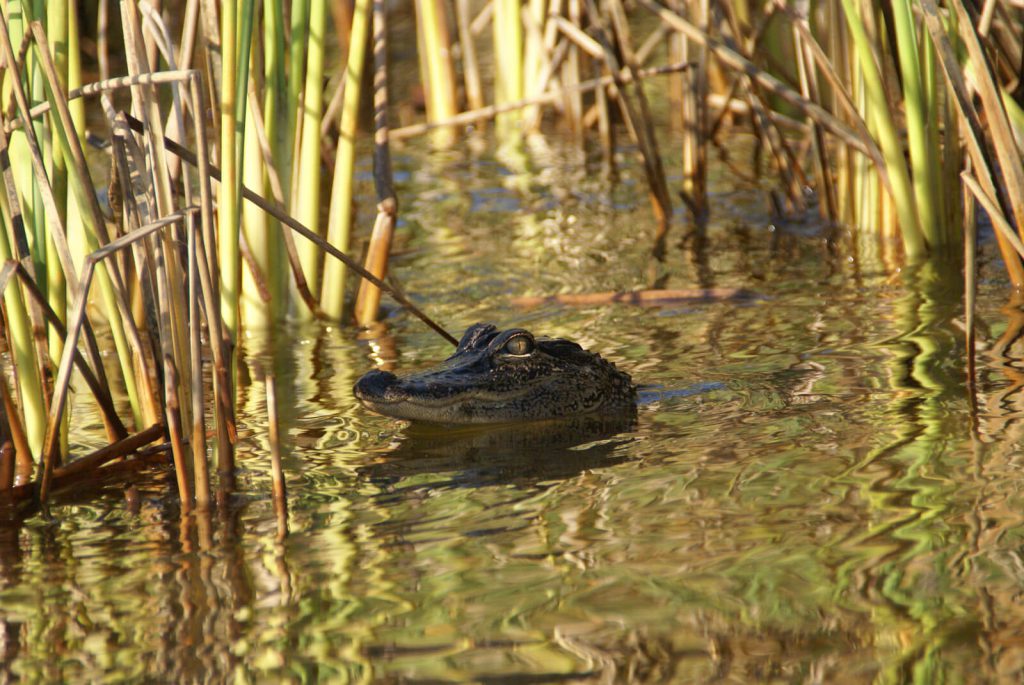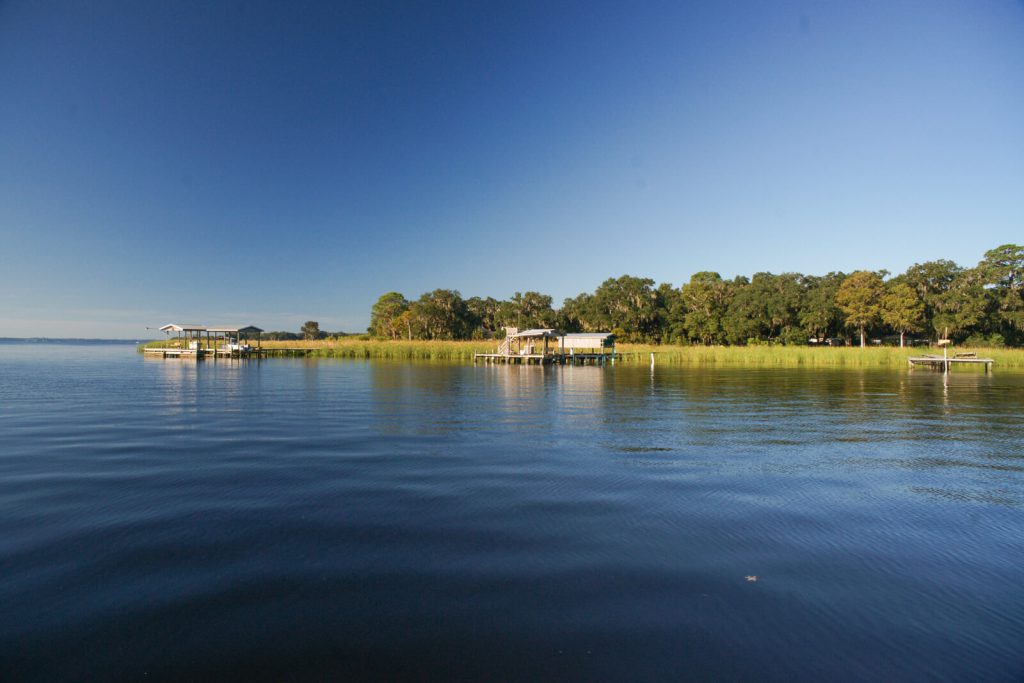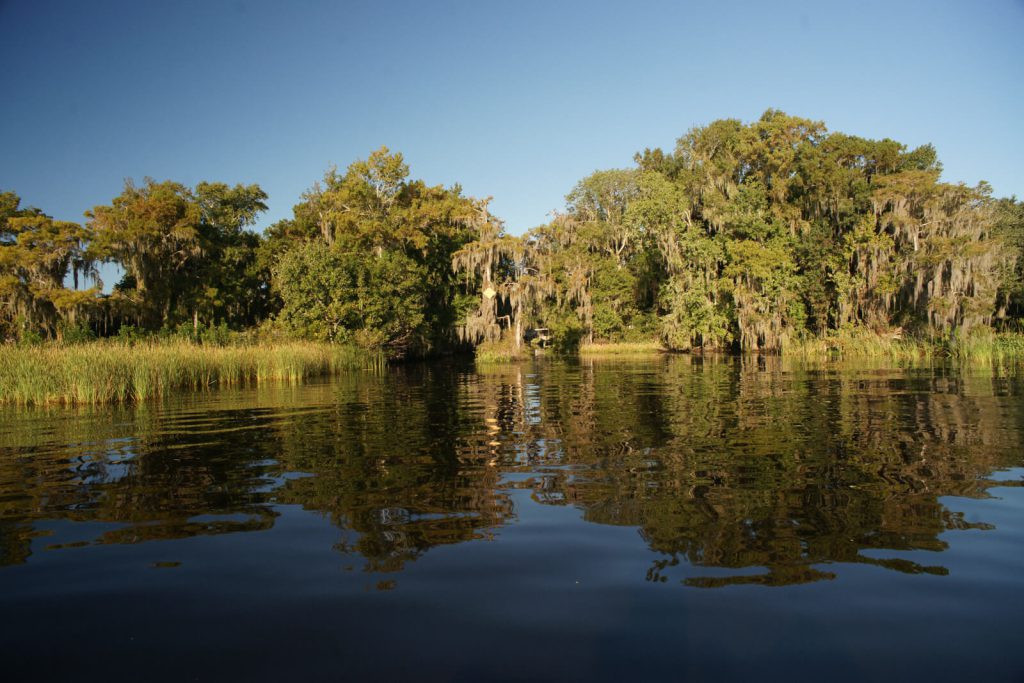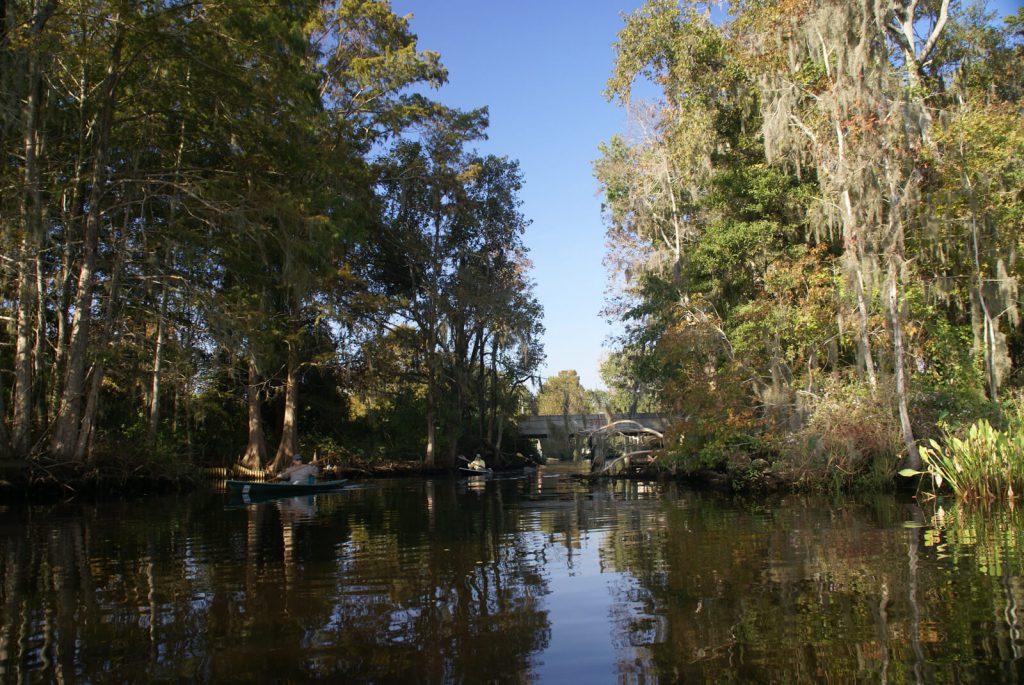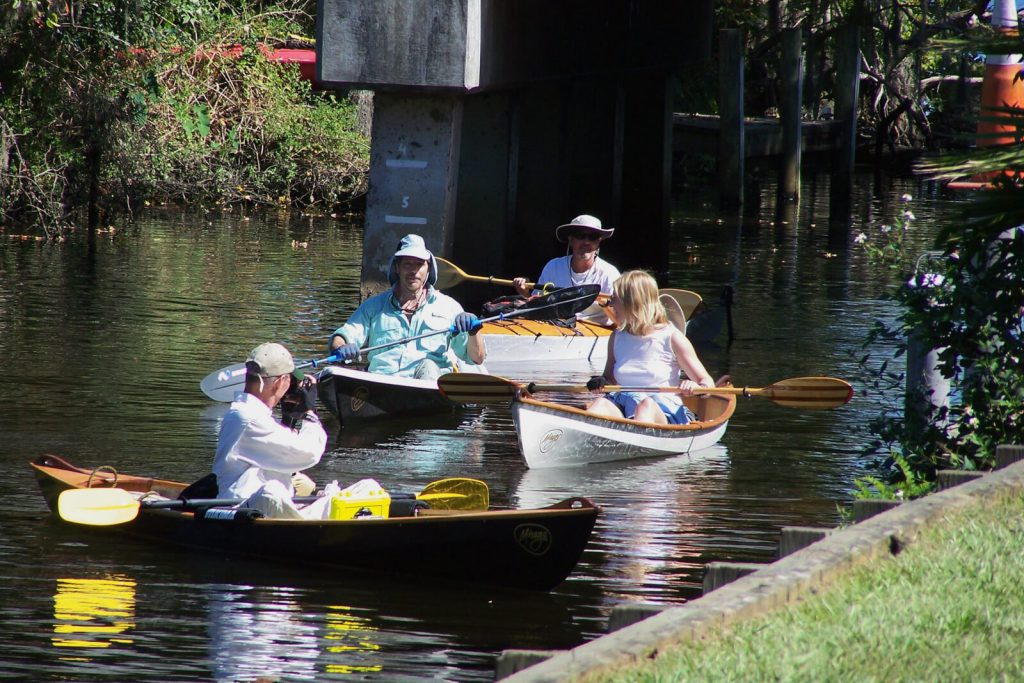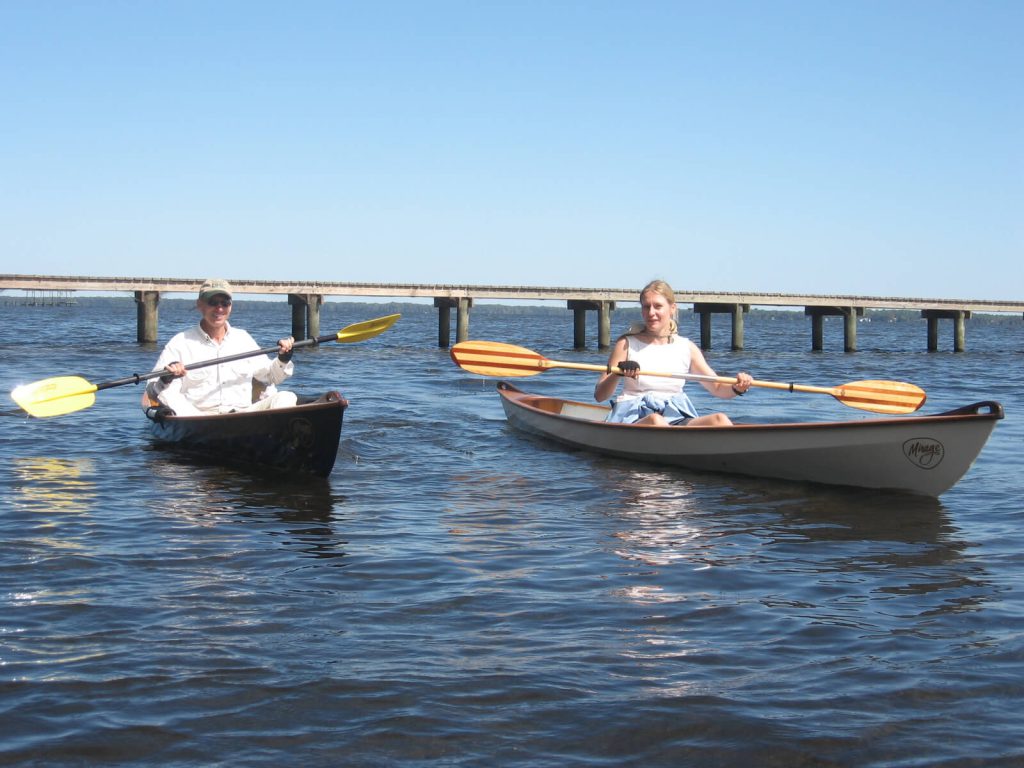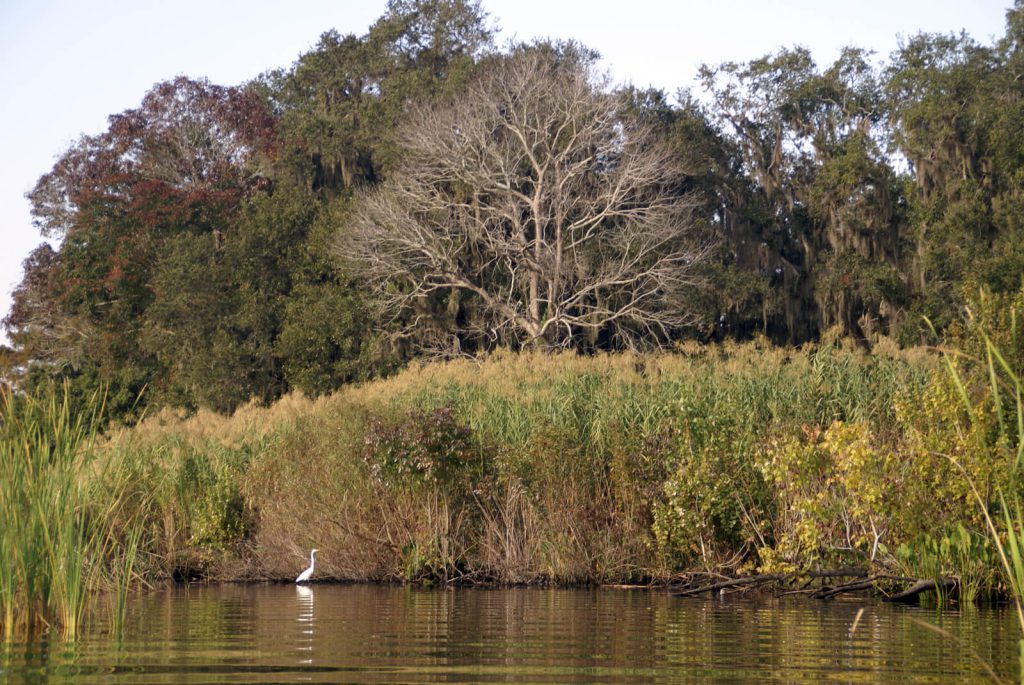01 Palmetto Bluff
Putnam County


We then soon crossed the river to a point, where we lodged, and saw many rocks of congealed snail and muscle-shells; here was a patch of good swamp, but the pine-lands approached near the river, and generally a perch or more of palmetto-ground, gently rising between the swamp and pine-land.
John and William Bartram
The Route
The Bartrams spent the night of December 23, 1765 at Picolata. When they arose on the morning of the 24th, it was a cold 50 degrees and the wind was blowing fresh out of the NW. With the wind at their backs, they rowed south for an unspecified distance and landed to hunt for food and survey the land along the east shore. They returned to their boat and crossed the river into today’s Putnam County, landing at a point on the west shore where they set up camp for the night of the 24th (Figure 1). The following morning, described as “cool and hazy”, the Bartrams continued south describing a route of several miles that passed by “choice swamps by the river” and made a stop at the site of an ancient plantation of Indians or Spaniards before proceeding on to “squire Roll’s.” The upstream route to and from this site is fairly well described in the Journal. It is likely that the hunting trip occurred a little past the halfway point between Picolata and Palmetto Bluff, in the neighborhood of today’s Riverdale in St. Johns County, just north of Racy Point. It is also likely that the Bartram’s camped near that same location on their return trip on the night of January 31, 1766 as Picolata, the departure point on the morning of the 24th, was reached by noon on February 1st.
The Campsite
John Bartram’s Journal describes the campsite in one sentence. The presence of large rocks of congealed snail and muscle-shells may be useful in locating the site where pine uplands are close to the river and transition down a gentle slope of palmetto to a patch of swamp.
Nine Mile Point is the most prominent point of land on the west shore south of Picolata (Figure 2). It is located just shy of 11 miles upstream from the likely site of the old fort. Allowing for a fresh tail wind this distance could have been covered easily even with the lengthy hunting stop described in the Journal. Harper (Bartram 1942) contends that the campsite was established at this point, however the entire point is comprised of wetlands and given the description contained in the Journal was more likely passed by for the next most prominent point of land at Palmetto Bluff which is comprised of higher ground (Figure 3, Putnam County GIS contour map).
They passed this site again on the 31st of January on their return trip down river but did not mention stopping here, but rather rowed along the east shore of the river and into what was described as a “great cove, on the north side of which is a fine rich high swamp” (Journal entry January 31, 1766) and camped on the opposite shore. This later description fits the cove between Racy and Federal points at the mouth of Deep Creek. This lends some credence to the location of this site (Palmetto Bluff) as the camp of December 24 since they would likely have wanted to see the land on the opposite shore missed during the upstream passage.
William Bartram
The Route
William Bartram returned to Putnam County sometime shortly after the middle of April 1774. His mode of travel was a small boat or canoe fitted with a sail. Because of the small size of his boat, he preferred to stay close to the shoreline in the broad lower St. Johns River, a preference which also afforded him a good view of shoreline flora and fauna. William’s Travels describes arriving at the site of Fort Picolata at noon and, after spending some time examining the remains of the dismantled fort, proceeding on his upstream voyage. By early evening he reached a “little lagoon” on the west shore (Figure 1).
The Campsite
Florida History Online suggests that this site described in the Journal is also the likely site described by William in Travels upstream of Fort Picolata. It makes sense that William would purposely revisit this campsite used during his trip up the St. Johns with his father, nearly ten years earlier. His description of a “little lagoon” on the west shore within a few hours sailing distance of Picolata (where he arrived at noon), fits this location, and fits nicely with the elevated situation at Palmetto Bluff (Figure 2) and the little lagoon between the Bluff and Nine Mile Point.
It was on his voyage to this site where he observed the mayfly emergence which led to his famous oratory on the Ephemera. After spending a pleasant night here, William, according to the account in Travels, awoke to a strong southerly breeze and decided to spend most of the day at the site surveying and describing the vegetation before setting sail in the evening, only to cross the river to a good harbor on the east shore where he camped the following night.
It is interesting to note that these two sites were not mentioned in William’s report to Dr. John Fothergill (Report). Rather, that account describes a one-day sail of 30 miles from a campsite two miles south of Fort Picolata, past this site and on to Villa Role (Rollestown) where he spent the next night (Page 143).
Harper (1958) in his commentary on Travels, suggests that this site described by William was the same as that described in his Report, and therefore located two miles south of Picolata on the west shore at the mouth of Clarks Creek in Clay County. He further suggests that the subsequent campsite described in Travels was across the river between Tocoi Creek and Racy Point.
If Harper is correct and William’s entry into Putnam County is more accurately described in his Report than in his Travels, then it makes sense that the description of a site on the west shore south of Picolata included in the latter document may, in fact, be based on his observations made at this campsite during his visit in 1765 as recorded in John Bartram’s Journal.
Batram Trail Site marker number 1 is located adjacent to the Palmetto Bluff boat ramp and can be reached by land or water via a short canal that flows under Cedar Creek Road to the River (Figure 4).
William Bartram Travels
LEAVING Picolata, I continued to ascend the river. I observed this day, during my progress up the river, incredible numbers of small flying insects, of the genus, termed by naturalists, Ephemera, continually emerging from the shallow water, near shore, some of them immediately taking their flight to the land, whilst myriads, crept up the grass and herbage, where remaining, for a short time, as they acquired sufficient strength, they took their flight also, following their kindred, to the main land. This resurrection from the deep, if I may so express it, commences early in the morning, and ceases after the sun is up. At evening they are seen in
Page 81
clouds of innumerable millions, swarming and wantoning in the still air, gradually drawing near the river, descend upon its surface, and there quickly end their day, after committing their eggs to the deep; which being for a little while tossed about, enveloped in a viscid scum, are hatched, and the little Larva descend into their secure and dark habitation, in the oozy bed beneath, where they remain, gradually increasing in size, until the returning spring; they then change to a Nymph, when the genial heat brings them, as it were, into existence, and they again arise into the world. This fly seems to be delicious food for birds, frogs and fish. In the morning, when they arise, and in the evening, when they return, the tumult is great indeed, and the surface of the water along shore broken into bubbles, or spirted into the air, by the contending aquatic tribes, and such is the avidity of the fish and frogs, that they spring into the air, after this delicious prey.
EARLY in the evening, after a pleasant days voyage, I made a convenient and safe harbour, in a little lagoon, under an elevated bank, on the West shore of the river, where I shall intreat the reader’s patience, whilst we behold the closing scene of the short-lived Ephemera, and communicate to each other the reflections which so singular an exhibition might rationally suggest to an inquisitive mind. Our place of observation is happily situated, under the protecting shade of majestic Live Oaks, glorious Magnolias and the fragrant Orange, open to the view of the great river, and still waters of the lagoon just before us.
AT the cool eves approach, the sweet enchanting
Page 82
melody of the feathered songsters gradually ceases, and they betake themselves to their leafy coverts for security and repose.
SOLEMNLY and slowly move onward, to the river’s shore, the rustling clouds of the Ephemera. How awful the procession! innumerable millions of winged beings, voluntarily verging on to destruction, to the brink of the grave, where they behold bands of their enemies with wide open jaws, ready to receive them. But as if insensible of their danger, gay and tranquil each meets his beloved mate, in the still air, inimitably bedecked in their new nuptial robes. What eye can trace them, in their varied wanton amorous chaces, bounding and fluttering on the odoriferous air? with what peace, love and joy, do they end the last moments of their existence?
I THINK we may assert, without any fear of exaggeration, that there are annually of these beautiful winged beings, which rise into existence, and for a few moments take a transient view of the glory of the Creator’s works, a number greater than the whole race of mankind that have ever existed since the creation; and that only, from the shore of this river. How many then must have been produced since the creation, when we consider the number of large rivers in America, in comparison with which, this river is but a brook or rivulet.
THE importance of the existence of these beautiful and delicately formed little creatures, in the creation, whose frame and organization is equally wonderful, more delicate, and perhaps as complicated as that of the most perfect human being, is well worth a few moments contemplation; I mean particularly
Page 83
when they appear in the fly state. And it we consider the very short period, of that stage of existence, which we may reasonably suppose, to be the only space of their life that admits of pleasure and enjoyment, what a lesson doth it not afford us of the vanity of our own pursuits.
THEIR whole existence in this world, is but one compleat year, and at least three hundred and sixty days of that time, they are in the form of an ugly grub, buried in mud, eighteen inches under water, and in this condition scarcely locomotive, as each Larva or grub, has but its own narrow solitary cell, from which it never travels, or moves, but in a perpendicular progression, of a few inches, up and down, from the bottom to the surface of the mud, in order to intercept the passing atoms for its food, and get a momentary respiration of fresh air; and even here it must be perpetually on its guard, in order to escape the troops of fish and shrimps Watching to catch it, and from whom it has no escape, but by instantly retreating back into its cell. One would be apt almost to imagine them created merely for the food of fish and other animals.
HAVING rested very well during the night, I was awakened in the morning early, by the cheering converse of the wild turkey-cock (Meleagris occidentalis) saluting each other, from the sun-brightened tops of the lofty Cupressus disticha and Magnolia grandiflora. They begin at early dawn, and continue till sun rise, from March to the last of April. The high forests ring with the noise, like the crowing of the domestic cock, of these social centinels, the watch-word being caught and repeated, from one to another, for hundreds of miles
Page 84
around; insomuch that the whole country, is for an hour or more, in an universal shout. A little after sun-rise, their crowing gradually ceases, they quit their high lodging places, and alight on the earth, where, expanding their silver bordered train, they strut and dance round about the coy female, while the deep forests seem to tremble with their shrill noise.
THIS morning the winds on the great river, were high and against me, I was therefore obliged to keep in port, a great part of the day, which I employed in little excursions round about my encampment. The Live Oaks are of an astonishing magnitude, and one tree contains a prodigious quantity of timber, yet comparatively, they are not tall, even in these forests, where growing on strong land, in company with others of great altitude (such as Fagus sylvatica, Liquid-amber, Magnolia grandiflora, and the high Palm tree) they strive while young to be upon an equality with their neighbours, and to enjoy the influence of the sun-beams, and of the pure animating air; but the others at last prevail, and their proud heads are seen at a great distance, towering far above the rest of the forest, which consists chiefly of this species of oak, Fraxinus, Ulmus, Acer rubrum, Laurus Borbonia, Quercus dentata, Ilex aquifolium, Olea Americana, Morus, Gleditsia triacanthus, and I believe a species of Sapindus. But the latter spreads abroad his brawny arms, to a great distance. The trunk of the Live Oak is generally from twelve to eighteen feet in girt, and rises ten or twelve feet erect from the earth; some I have seen eighteen or twenty; then divides itself into three, four, or five great limbs,
Page 85
which continue to grow in nearly an horizontal direction, each limb forming a gentle curve, or arch, from its base to its extremity. I have stepped above fifty paces, on a strait line, from the trunk of one of these trees, to the extremity of the limbs. They are ever green, and the wood almost incorruptible, even in the open air. It bears a prodigious quantity of fruit; the acorn is small, but sweet and agreeable to the taste when roasted, and is food for almost all animals. The Indians obtain from it a sweet oil, which they use in the cooking of hommony, rice, &c. and they also roast them in hot embers, eating them as we do chesnuts.
THE wind being fair in the evening, I sat sail again, and crossing the river, made a good harbour on the East shore, where I pitched my tent for the night.
© This work is the property of the University of North Carolina at Chapel Hill. It may be used freely by individuals for research, teaching and personal use as long as this statement of availability is included in the text.
December 24, 1765 Journal Entry
“Cold morning, thermometer 50, wind N.W. Blowed pretty fresh, but ceased toward night; landed, and Mr. Davis shot a deer, and his Negro a turkey. I and my son walked in the woods to observe the soil and plants, with a man that went to fell some trees for honey: he felled one that contained only some yellow wasps, that had taken up their winter-quarters in a pine-tree; we then walked to another hollow tree, wherein was a swarm of bees and some honey; but both the white people and Indians often meet with such good success, as to find great quantities of honey and wax, even ten gallons, more or less, out of one tree; the Indians eat much of it with their venison and sour oranges, of which they cut off one end, then pour the honey into the pulp, and scoop both out as a relishing morsel. We then soon crossed the river to a point, where we lodged, and saw many rocks of congealed snail and muscle-shells; here was a patch of good swamp, but the pine-lands approached near the river, and generally a perch or more of palmetto-ground, gently rising between the swamp and pine-land.”
December 25, 1765 Journal Entry
“Cool hazy morning, thermometer 46 in the open air, (in which all my thermometrical observations up the river are taken).” After several miles, [passing] by choice swamps near the river, we landed at a point of high ground, which has been an ancient plantation of Indians or Spaniards; many live oak-trees grew upon it near two foot diameter, and plenty of oranges; the soil was sandy but pretty good; we walked back from the river, the ground rising gradually from the swamp on the right-hand, where grow small ever-green-oaks, hiccory, chinquapins, and great magnolia, and in the swamp grows the swamp or northern kind 18 inches diameter, and 60 foot high, liquid-amber and red-maple 3 foot diameter, elm, ash, and bays; the plants were most sorts of the northern ferns, saururus, iris, pancratium, large long flowering convolvulus running 20 foot high, chenopodium as high, and 4 inches diameter, pontedereia and dracontium. Cloudy cool day, arrived at squire Roll’s,”
Travels
Bartram, William. Travels Through North & South Carolina, Georgia, East & West Florida, the Cherokee Country, the Extensive Territories of the Muscogulges, or Creek Confederacy, and the Country of the Chactaws; Containing An Account of the Soil and Natural Productions of Those Regions, Together with Observations on the Manners of the Indians. Embellished with Copper-Plates. James and Johnson Publishers. 1791. Electronic Edition.
http://docsouth.unc.edu/nc/bartram/bartram.html
Harper, Francis, ed. The Travels of William Bartram, Naturalist’s Edition. Yale University Press. New Haven. 1958.
Report
Bartram, William. Annotated by Francis Harper. Travels in Georgia and Florida, 1773-74; a report to Dr. John Fothergill. Annotated by Francis Harper. Transactions of the American Philosophical Society, n.s., Vol. XXXIII, Pt. II. Philadelphia, PA, 1943.
http://babel.hathitrust.org/cgi/pt?id=mdp.39015021105773#view=1up;seq=7
The Journal
Florida History Online “John Bartram’s Travels on the St. Johns River, 1765-1766.” May 2013.
http://www.unf.edu/floridahistoryonline/Projects/Bartram.html
John Bartram’s Journal Entries for December 24 and 25, 1765:
http://www.unf.edu/floridahistoryonline/Bartram/December_1765/24dec1765.htm
http://www.unf.edu/floridahistoryonline/Bartram/December_1765/25dec1765.htm
Bartram, John. Diary of a Journey through the Carolinas, Georgia, and Florida, from July 1, 1765, to April 10, 1766, annotated by Francis Harper. Transactions of the American Philosophical Society, n.s., Vol. XXXIII, Pt. I. Philadelphia, PA, 1942.
Additional References
Florida History Online. New World in a State of Nature; British Plantations and Farms on the St. Johns River, East Florida 1763-1784. May 2013
http://www.unf.edu/floridahistoryonline/Projects/Plantations.html
Bruce, F.W. Assistant Engineer, US Army Corps of Engineers. St. Johns River to Lake Harney, Florida. 1908. The Portal to Texas History. University of North Texas. Nautical Chart of the St. Johns River.
http://texashistory.unt.edu/ark:/67531/metapth187523/m1/1/zoom/
Florida Museum of Natural History. Florida Naturalists. William Bartram. Book of Travels. May 2013
